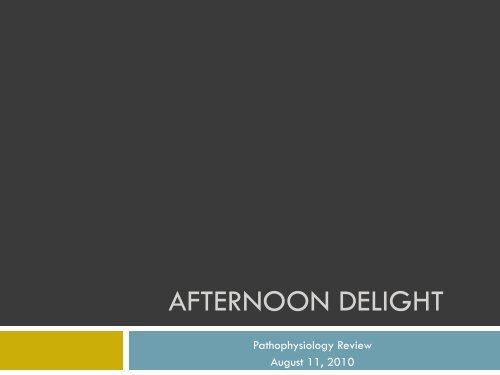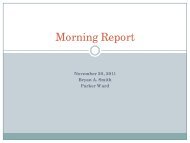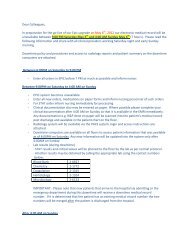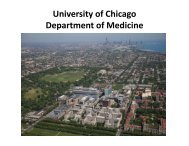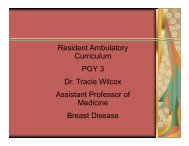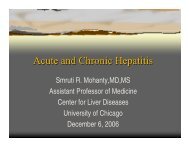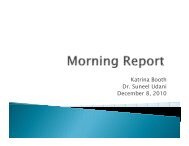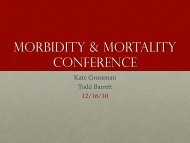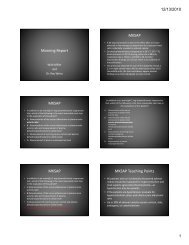afternoon delight - The University of Chicago Department of Medicine
afternoon delight - The University of Chicago Department of Medicine
afternoon delight - The University of Chicago Department of Medicine
Create successful ePaper yourself
Turn your PDF publications into a flip-book with our unique Google optimized e-Paper software.
AFTERNOON DELIGHT<br />
Pathophysiology Review<br />
August 11, 2010
Case<br />
A 54-year-old man is evaluated in the emergency department for a 1hour<br />
history <strong>of</strong> chest pain with mild dyspnea. <strong>The</strong> patient had been<br />
hospitalized 1 week ago for a colectomy for colon cancer. His medical<br />
history also includes hypertension and nephrotic syndrome secondary to<br />
membranous glomerulonephritis, and his medications are furosemide,<br />
ramipril, and pravastatin.<br />
On physical examination, the temperature is 37.5 °C (99.5 °F), the<br />
blood pressure is 110/60 mm Hg, the pulse rate is 120/min, the<br />
respiration rate is 24/min, and the BMI is 30. Oxygen saturation is 89%<br />
with the patient breathing ambient air and 97% on oxygen, 4 L/min.<br />
Cardiac examination shows tachycardia and an S 4. Breath sounds are<br />
normal. Serum creatinine concentration is 1.1 mg/dL (185.6 µmol/L).<br />
Chest radiograph is negative for infiltrates, widened mediastinum, and<br />
pneumothorax.
EKG
PE protocol CT
What happened?<br />
4:45<br />
pm<br />
History<br />
6:45<br />
pm<br />
Physical<br />
Exam<br />
7:05<br />
pm<br />
Diagnostic<br />
tests<br />
9:10<br />
am<br />
HD<br />
Monitor Treatment<br />
#5
Why?<br />
4:45<br />
pm<br />
History<br />
6:45<br />
pm<br />
Physical<br />
Exam<br />
7:05<br />
pm<br />
Diagnostic<br />
tests<br />
9:10<br />
am<br />
HD<br />
Monitor Treatment<br />
#5
What historical elements increase the<br />
pretest probability <strong>of</strong> PE?<br />
4:45<br />
pm<br />
History<br />
A 54-year-old man is evaluated in the emergency<br />
department for a 1-hour history <strong>of</strong> chest pain with mild<br />
dyspnea. <strong>The</strong> patient had been hospitalized 1 week ago<br />
for a colectomy for colon cancer. His medical history also<br />
includes hypertension and nephrotic syndrome secondary<br />
to membranous glomerulonephritis, and his medications<br />
are furosemide, ramipril, and pravastatin.<br />
On physical examination, the temperature is 37.5 °C (99.5<br />
°F), the blood pressure is 110/60 mm Hg, the pulse rate<br />
is 120/min, the respiration rate is 24/min, and the BMI is<br />
30. Oxygen saturation is 89% with the patient breathing<br />
ambient air and 97% on oxygen, 4 L/min. Cardiac<br />
examination shows tachycardia and an S 4. Breath sounds<br />
are normal. Serum creatinine concentration is 1.1 mg/dL<br />
(185.6 µmol/L). Chest radiograph is negative for<br />
infiltrates, widened mediastinum, and pneumothorax.
What historical elements increase the<br />
pretest probability <strong>of</strong> PE?<br />
4:45<br />
pm<br />
History<br />
* Ann Intern Med 2001;135:98-107<br />
**JAMA. 2006;295:172-179<br />
N Engl J Med 2008;358:1037-52.<br />
1.3% had PE<br />
16.2% had PE<br />
37.5% had PE*<br />
12.1% had PE: +D-dimer 23.2% had PE, -D-dimer 0.5% PE<br />
37.1% had PE**
What historical elements increase the<br />
pretest probability <strong>of</strong> PE?<br />
4:45<br />
pm<br />
History<br />
A 54-year-old man is evaluated in the emergency<br />
department for a 1-hour history <strong>of</strong> chest pain with mild<br />
dyspnea. <strong>The</strong> patient had been hospitalized 1 week ago<br />
for a colectomy for colon cancer. His medical history also<br />
includes hypertension and nephrotic syndrome secondary<br />
to membranous glomerulonephritis, and his medications<br />
are furosemide, ramipril, and pravastatin.<br />
On physical examination, the temperature is 37.5 °C (99.5<br />
°F), the blood pressure is 110/60 mm Hg, the pulse rate<br />
is 120/min, the respiration rate is 24/min, and the BMI is<br />
30. Oxygen saturation is 89% with the patient breathing<br />
ambient air and 97% on oxygen, 4 L/min. Cardiac<br />
examination shows tachycardia and an S 4. Breath sounds<br />
are normal. Serum creatinine concentration is 1.1 mg/dL<br />
(185.6 µmol/L). Chest radiograph is negative for<br />
infiltrates, widened mediastinum, and pneumothorax.
What historical elements increase the<br />
pretest probability <strong>of</strong> PE?<br />
4:45<br />
pm<br />
History<br />
* Ann Intern Med 2001;135:98-107<br />
**JAMA. 2006;295:172-179<br />
37.1% had PE**<br />
N Engl J Med 2008;358:1037-52.<br />
37.5% had PE*
Why?<br />
4:45<br />
pm<br />
History<br />
6:45<br />
pm<br />
Physical<br />
Exam<br />
7:05<br />
pm<br />
Diagnostic<br />
tests<br />
9:10<br />
am<br />
HD<br />
Monitor Treatment<br />
#5
6:45<br />
pm<br />
Mechanisms <strong>of</strong> Hypoxemia<br />
Physical<br />
Exam<br />
Decreased Inspired Oxygen<br />
Hypoventilation<br />
V/Q mismatch<br />
Shunt<br />
Venous Admixture
6:45<br />
pm<br />
Decreased Inspired Oxygen<br />
Physical<br />
Exam<br />
PI O2=<br />
FI O2 x (P atm –P H2O )<br />
PAO2= FIO2 x (Patm –PH2O ) – PCO2/R Mason: Murray and Nadel's Textbook <strong>of</strong> Respiratory <strong>Medicine</strong>, 5th ed.<br />
A decrease in<br />
inspired oxygen (PI O2)<br />
leads to a decrease<br />
in the PA O2.<br />
As a result the driving<br />
pressure <strong>of</strong> oxygen<br />
through the alveolarcapillary<br />
membrane<br />
(ie the Aa gradient) is<br />
reduced and<br />
hypoxemia occurs.
6:45<br />
pm<br />
Mechanisms <strong>of</strong> Hypoxemia<br />
Physical<br />
Exam<br />
Decreased Inspired Oxygen<br />
Hypoventilation<br />
V/Q mismatch<br />
Shunt<br />
Venous Admixture
6:45<br />
pm<br />
Hypoventilation<br />
Physical<br />
Exam<br />
When you hypoventilate, what happens to your P CO2 ?<br />
PA O2= FI O2 x (P atm –P H2O ) -<br />
Drive<br />
CNS Drive<br />
1. Narcotics<br />
2. Mass lesions<br />
Metabolic Drive<br />
1. Alkalosis<br />
2. Acidosis<br />
Respiratory Muscles<br />
• Muscular dystrophy<br />
• Myositis<br />
• Diaphragm weakness<br />
• Hypothyroidism<br />
Neurologic conditions<br />
• Myasthenia Gravis<br />
• Spinal cord injury<br />
• ALS/MS/GBS<br />
P CO2/R<br />
Strength Load<br />
Chest wall<br />
•Kyphosis, Obesity<br />
Lungs<br />
•Fibrosis<br />
Airways<br />
•Asthma, COPD<br />
Metabolic demands<br />
•Exercise, sepsis
6:45<br />
pm<br />
Mechanisms <strong>of</strong> Hypoxemia<br />
Physical<br />
Exam<br />
Decreased Inspired Oxygen<br />
Hypoventilation<br />
V/Q mismatch<br />
Shunt<br />
Venous Admixture
6:45<br />
pm<br />
V/Q mismatch<br />
Physical<br />
Exam<br />
Low V/Q:<br />
Open alveoli, but low<br />
airflow (atelectasis,<br />
bronchospasm, partial<br />
obstruction <strong>of</strong> airway)<br />
Mason: Murray and Nadel's Textbook <strong>of</strong> Respiratory <strong>Medicine</strong>, 5th ed.<br />
Right to Left Shunt:<br />
passage <strong>of</strong> venous blood into<br />
the arterial circulation w/o<br />
passing ventilated alveoli<br />
Pa O2≈Mv O2<br />
High V/Q:<br />
Increasing<br />
dead space<br />
(PE,<br />
hypovolemia)<br />
Dead Space:<br />
alveolar units are<br />
fully ventilated<br />
but not perfused<br />
Pa O2≈ Pi O2
6:45<br />
pm<br />
Mechanisms <strong>of</strong> Hypoxemia<br />
Physical<br />
Exam<br />
Decreased Inspired Oxygen<br />
Hypoventilation<br />
V/Q mismatch<br />
Shunt<br />
Venous Admixture
Shunt<br />
Passage <strong>of</strong><br />
venous blood<br />
into the arterial<br />
circulation w/o<br />
passing<br />
ventilated<br />
alveoli<br />
6:45<br />
pm<br />
Physical<br />
Exam<br />
Kliegman: Nelson Textbook <strong>of</strong> Pediatrics, 18th ed.<br />
Hypoxemia caused by shunt is characterized by the failure<br />
<strong>of</strong> PaO 2 to rise despite inhalation <strong>of</strong> pure oxygen (100%).<br />
Intrapulmonary Shunt Extrapulmonary Shunt<br />
Pulmonary arteriovenous<br />
malformations<br />
hepatopulmonary<br />
syndrome<br />
+/- alveolar<br />
consolidation or collapse<br />
Atrial septal defect<br />
Ventricular septal defect<br />
Patent ductus arteriosis<br />
Anomalous pulmonary<br />
venous circulation<br />
Due to deoxygenated blood returning to the left atrium from the<br />
thebesian veins and from the bronchial circulation <strong>of</strong> the airways,<br />
there is a normal (anatomic) shunt <strong>of</strong> 5% in normal individuals.
6:45<br />
pm<br />
Mechanisms <strong>of</strong> Hypoxemia<br />
Physical<br />
Exam<br />
Decreased Inspired Oxygen<br />
Hypoventilation<br />
V/Q mismatch<br />
Shunt<br />
Venous Admixture
6:45<br />
pm<br />
Venous Admixture<br />
Physical<br />
Exam<br />
Kliegman: Nelson Textbook <strong>of</strong> Pediatrics, 18th ed.
6:45<br />
pm<br />
Venous Admixture: heart failure<br />
Physical<br />
Exam<br />
60%<br />
60%<br />
60%<br />
85% 65% 75%
6:45<br />
pm<br />
What is the primary mechanism <strong>of</strong><br />
Hypoxia for PE?<br />
Physical<br />
Exam<br />
V/Q mismatch<br />
Increases the amount <strong>of</strong> dead space<br />
How can PE cause shunt physiology?<br />
Acquired PFO<br />
Atelectasis in infarcted segment
Why?<br />
4:45<br />
pm<br />
History<br />
6:45<br />
pm<br />
Physical<br />
Exam<br />
7:05<br />
pm<br />
Diagnostic<br />
tests<br />
9:10<br />
am<br />
HD<br />
Monitor Treatment<br />
#5
7:05 7:05<br />
pm<br />
pm<br />
Comparison <strong>of</strong> tests<br />
Diagnostic<br />
tests<br />
CLEVELAND C.LINIC JOURNAL OF MEDICINE 2002; 69: 721-29.
7:05<br />
pm<br />
What about a V/Q scan?<br />
Diagnostic<br />
tests<br />
JAMA 1990; 263:2753–2759.<br />
CLEVELAND C.LINIC JOURNAL OF MEDICINE 2002; 69: 721-29.
7:05 7:05<br />
pm<br />
Diagnostic<br />
tests<br />
pm<br />
N Engl J Med 2008;359:2804-13.<br />
Pre-test Probability:<br />
important in<br />
choosing your next<br />
diagnostic test
Why?<br />
4:45<br />
pm<br />
History<br />
6:45<br />
pm<br />
Physical<br />
Exam<br />
7:05<br />
pm<br />
Diagnostic<br />
tests<br />
9:10<br />
am<br />
HD<br />
Monitor Treatment<br />
#5
Why are PE’s so deadly?<br />
9:10<br />
am Monitor<br />
Hypoxemia<br />
RV dysfunction
S1Q3T3: a<br />
sign <strong>of</strong> acute<br />
cor pulmonale<br />
EKG DDx: PE, acute bronchospasm, pneumothorax, and other acute lung<br />
disorders.<br />
− An S wave in lead I signifies a complete or more <strong>of</strong>ten incomplete RBBB<br />
− In lead III, look for a Q wave, slight ST elevation, and an inverted T wave. <strong>The</strong>se<br />
findings are due to the pressure and volume overload over the right ventricle<br />
which causes repolarization abnormalities.
9:10<br />
am<br />
How does RV dysfunction cause shock?<br />
Monitor<br />
As the right ventricle<br />
dilates, the interventricular<br />
septum shifts toward the<br />
left, resulting in left<br />
ventricular underfilling and<br />
decreased left ventricular<br />
diastolic distensibility.<br />
Consequently, systemic<br />
cardiac output and systolic<br />
arterial pressure decline,<br />
thereby impairing coronary<br />
perfusion and causing<br />
myocardial ischemia.
How does PE cause Myocardial<br />
ischemia?<br />
Myocardial<br />
ischemia occurs<br />
whenever<br />
demand<br />
exceeds<br />
supply…<br />
9:10<br />
am Monitor<br />
Elevated right ventricular wall tension reduces right coronary artery blood flow,<br />
increases right ventricular myocardial oxygen demand, and causes coronary<br />
arterial ischemia.<br />
Hypoxemia further diminishes limited myocardial oxygen supply.<br />
Ultimately, right ventricular infarction, circulatory collapse, and death may<br />
ensue.<br />
Demand<br />
1. Heart Rate<br />
2. Systolic Blood pressure<br />
3. Wall Tension<br />
• LVEDP/Preload<br />
• Wall thickness<br />
4. Contractility<br />
Supply<br />
1. O2 carrying capacity<br />
• PaO2 tension<br />
• Hemoglobin<br />
2. O2 extraction<br />
3. Coronary blood flow
Terminology<br />
9:10<br />
am Monitor<br />
Massive PE: presence <strong>of</strong> cardiogenic shock,<br />
persistent arterial hypotension, or both.<br />
accounts for 5% <strong>of</strong> all cases <strong>of</strong> pulmonary embolism<br />
Submassive PE: normotensive patients who<br />
may have an elevated risk <strong>of</strong> death because<br />
<strong>of</strong> right ventricular dysfunction or injury to the<br />
myocardium<br />
Among hemodynamically stable PE patients,<br />
elevated troponin levels were associated with a<br />
6-fold increased mortality.
9:10<br />
am Monitor<br />
Risk factors for mortality<br />
Age >70<br />
Cancer<br />
Clinical CHF<br />
COPD<br />
SBP20<br />
RV Hypokinesis<br />
Lancet 1999;353:1386–1389<br />
Circulation 2005;112;e28-e32
Why?<br />
4:45<br />
pm<br />
History<br />
6:45<br />
pm<br />
Physical<br />
Exam<br />
7:05<br />
pm<br />
Diagnostic<br />
tests<br />
9:10<br />
am<br />
HD<br />
Monitor Treatment<br />
#5
HD<br />
#5 Treatment<br />
Treatment <strong>of</strong> Acute PE<br />
1. Active cancer<br />
2. Unprovoked<br />
Pulmonary Embolism<br />
3. Recurrent venous<br />
thromboembolism<br />
N Engl J Med 2010;363:266-74.
HD<br />
#5 Treatment


